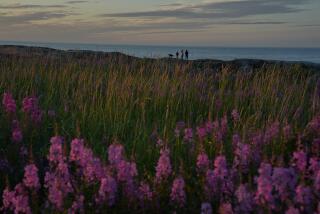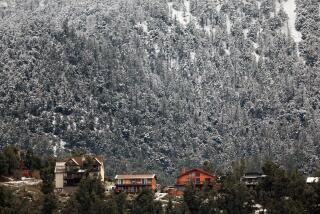One Small Town Puts Trade Center Toll in Frightening New Perspective
BIG BEAR LAKE â Take it all in. Take a long, long look at Big Bear Lake.
At American Legion Post 584, where the haze rising from the cigarettes clouds the framed picture of John Wayne and the Pearl Harbor headline clipped 60 years ago from the Des Moines Register.
At the mega-house going up on the lakefront, the place thatâs got everybody gossiping over whoâs building it, maybe Kevin Costner or some porno millionaire.
At the Mexican restaurant where the crews are hustling to layer on stucco before the weather turns to winter.
At the brand-new firehouse, and the crew-cut kid smoking a cigarette as he strolls past in a black T-shirt reading âTodayâs youth, tomorrowâs leaders, everyoneâs future.â
At the nesting trees for the bald eagles, George and Gracie, who come back here with the snowfall.
Now, wipe it all out of your head. Wipe it all off the map.
Big Bear Lake, gone.
No red-planked Bowling Barn. No hormonal kids posturing and flirting on the porch of the Super Bear Arcade. No Shirley Jones and Marty Ingels this Saturday, one night only, at the Performing Arts Center. No Chevron station with the God Bless America sign made by Barbara Poulter, veteranâs wife. No OCI, Old Country Inn, where the waitresses serve the cheeseburgers and potato pancakes in red, white and blue memorial T-shirts. No Boulevard Antiques, where, amid the costume jewelry and wooden bear carvings, Scottish-born Pat Murray is readying herself for the last test she has to take to become an American citizen.
The World Trade Center was a towering hive of commerce. Big Bear Lake is a low, lanky town spread along the south shore of its eponymous lake. The World Trade Center stood at the nucleus of the world. Big Bear Lake is found off a highway called the Rim of the World. The World Trade Center was a bustle of suits and ties. Big Bear Lake wears sweatshirts and Gore-Tex.
And yet these two places, so different, are linked by one thing: people. The number of people believed to have died in the World Trade Center is 6,477, just about the number of souls who inhabit Big Bear Lake, year round. When the World Trade Center was wiped out, so was the equivalent of an entire American town. Like this town.
Teenage girls in low-slung pants lounge past the Edelweiss bookstore, past the collage of photos in the window, images of firemen cut from newspapers and pasted onto a rectangle of cardboard reading âOur Heroes!â
Lorie Lopez made that sign, and works in this store. She had a bouquet of American flags on display out front, too, but so many people were snatching them up and carrying them in and wanting to know, âHow much? How much?â that she had to bring them inside. For two weeks now, there hasnât been a flag to be had for love or money in Big Bear Lake--sold out. Not even the American Legion post, the nationâs highest if you donât believe the boys over in Flagstaff, has been able to restock its $13 nylon flags since Sept. 11.
Since Sept. 11, Lorie Lopez has thought much upon âthe event,â âSeptember 11,â âthe thing,â as people variously name it.
There are some ways she can get her mind around how real âthe thingâ is, and how close: A customerâs cousinâs wife was a flight attendant on one of the jets that hit the World Trade Center. Her son-in-law is a Marine down at Twentynine Palms, and her daughter and infant twins may move up here for the duration, whatever that is.
But that number, that 6,477--a whole town, like this town, blown off the landscape? âPeople you see at the grocery store, people who walk by and tap on the window, then all of a sudden, theyâre not there any more? No more tapping on the window? No heads popping in? It is just un-i-magin-able.â
Her daughter Brandi, the 19-year-old, comes into the store, and her mother unfurls the numbers for her.
âSo itâs like Big Bear Lake was wiped out,â says Brandi. âThatâs scary.â
âCan you imagine? One big hole from Motel Six all the way to the dam--pssh, gone.â
âI donât want to imagine that,â says Brandi.
I didnât want to any more, either. On the drive back from Big Bear Lake, I rounded a corner on the highway and saw a sky-high mountain of smoke, much like the one I saw in Manhattan a fortnight ago. The shock of it pulled a gasp out of me. Then I realized it was only a brush fire, and with the next thought realized how much had changed in a fortnight. Only a brush fire. The terror of a Southern California autumn now become almost a relief. Just a brush fire. Only a capricious act of nature, not a callous act of man.
*
Patt Morrisonâs column appears Mondays and Wednesdays. Her e-mail is [email protected]
More to Read
Sign up for Essential California
The most important California stories and recommendations in your inbox every morning.
You may occasionally receive promotional content from the Los Angeles Times.











